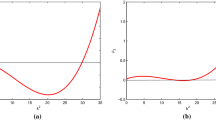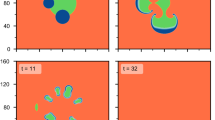Abstract
The spatio-temporal dynamics of three competitive species is considered. Mathematically, the community is described by a system of partial differential equations of Lotka-Volterra type. The properties of the system are investigated both numerically and analytically. We show that for finite initial conditions the dynamics of the system is typically reduced to a succession of travelling diffusive waves, some of which demonstrate rather an unusual behaviour. Particularly, a locally unstable equilibrium can become stable in the wake of a diffusive front. After propagation of the waves, the domain is invaded by irregular spatiotemporal population oscillations that can be classified as spatio-temporal chaos.
Similar content being viewed by others
References
S.R. Dunbar, Travelling waves in diffusive predator-prey equations: periodic orbits and point-to-periodic heteroclinic orbits. SIAM J. Appl. Math.,46 (1986), 1057–1078.
M. J.R. Fasham, The statistical and mathematical analysis of plankton patchiness. Oceanogr. Marine Biology Annual Rev.,16 (1978), 43–79.
P.C. Fife, Mathematical Aspects of Reacting and Diffusing Systems. Lecture Note in Biomathematics28, Springer-Verlag, Berlin, 1979.
R. Fisher, The wave of advance of advantageous genes. Ann. Eugenics,7 (1937), 255–369.
C. Godfray and M. Hassell, Chaotic beetles. Science,275 (1997), 323–326.
J. Hofbauer and K. Sigmund, The Theory of Evolution and Dynamical Systems. Cambridge Univ. Press, Cambridge UK, 1988.
Y. Hosono, The minimal speed of travelling fronts for a diffusive Lotka-Volterra competition model. Bull. Math. Biol.,60 (1998), 435–448.
K. Kawasaki, A limit cycle in a three competitive species community of Lotka-Volterra type. The Science and Engineering Review of Doshisha University, Kyoto, 2001, in press (in Japanese).
A.N. Kolmogorov, I.G. Petrovsky and N.S. Piskunov, A study of the equation of diffusion with increase in the quantity of matter, and its application to a biological problem. Moscow Univ. Bull. Math.,1 (1937), 1–25.
N. Kopell and L.N. Howard, Plane wave solutions to reaction-diffusion equations. Studies in Appl. Math.,52 (1973), 291–328.
S.A. Levin, Physical and biological scales and the modelling of predator-prey interactions in large marine ecosystems. Large Marine Ecosystems: Patterns, Processes and Yields (eds. K. Sherman, L.M. Alexander and B.D. Gold), AAAS, Washington, 1990.
S.A. Levin and L.A. Segel, A hypothesis for the origin of planktonic patchiness. Nature,259 (1976), 659.
H. Malchow, Flow- and locomotion-induced spatial pattern formation in nonlinear population dynamics. Ecological Modelling,82 (1995), 257–264.
H. Malchow and S.V. Petrovskii, Dynamical stabilization of unstable equilibrium in chemical and biological systems. Mathematical and Computer Modelling, (2001), in press.
R.M. May and W. Leonard, Nonlinear aspects of competition between three species. SIAM J. Appl. Math.,29 (1975), 243–252.
J.H. Merkin and M.A. Sadiq, The propagation of travelling waves in an open cubic autocatalytic chemical system. IMA J. Appl. Math.,57 (1996), 273–309.
J.H. Merkin, V. Petrov, S.K. Scott and K. Showalter, Wave-induced chemical chaos. Phys. Rev. Lett.,76 (1996), 546–549.
J.D. Murray, Mathematical Biology. Springer, Berlin, 1989.
T. Namba and M. Mimura, Spatial distribution of competing populations. J. Theor. Biol.,87 (1980), 795–814.
A.H. Nayfeh and B. Balachandran, Applied Nonlinear Dynamics. Wiley, New York, 1995.
A. Okubo, Diffusion and Ecological Problems: Mathematical Models. Springer, Berlin, 1980.
A. Okubo, P.K. Maini, M.H. Williamson and J.D. Murray, On the spatial spread of the gray squirrel in Britain. Proc. R. Soc. Lond., B238 (1989), 113–125.
M. Pascual, Diffusion-induced chaos in a spatial predator-prey system. Proc. R. Soc. Lond., B251 (1993), 1–7.
S.V. Petrovskii and H. Malchow, A minimal model of pattern formation in a prey-predator system. Mathematical and Computer Modelling,29 (1999), 49–63.
S.V. Petrovskii and H. Malchow, Critical phenomena in plankton communities: KISS model revisited. Nonlinear Analysis: Real World Applications,1 (2000), 37–51.
S.V. Petrovskii and H. Malchow, Wave of chaos: new mechanism of pattern formation in spatio-temporal population dynamics. Theor. Popul. Biol.,59 (2001), 157–174.
R. Pool, Ecologists flirt with chaos. Science,243 (1989), 310–313.
M. Scheffer, Should we expect strange attractors behind plankton dynamics — and if so, should we bother? J. Plankt. Res.,13 (1991), 1291–1305.
L.A. Segel and J.L. Jackson, Dissipative structure: an explanation and an ecological example. J. Theor. Biol.,37 (1972), 545–559.
J.A. Sherratt, M.A. Lewis and A.C. Fowler, Ecological chaos in the wake of invasion. Proc. Natl. Acad. Sci. USA,92 (1995), 2524–2528.
N. Shigesada, K. Kawasaki and E. Teramoto, Traveling periodic waves in heterogeneous environments. Theor. Popul. Biol.,30 (1986), 143–160.
N. Shigesada, Mathematical Modelling for Biological Invasions. University of Tokyo Press, Tokyo, 1992 (in Japanese).
N. Shigesada and K. Kawasaki, Biological Invasions: Theory and Practice. Oxford University Press, Oxford, 1997.
A.M. Turing, On the chemical basis of morphogenesis. Phil. Trans. R. Soc. Lond., B237 (1952), 37–72.
F. Verhulst, Nonlinear Differential Equations and Dynamical Systems. Springer-Verlag, Berlin, 1985.
V. Volterra, Variazioni e fluttuazioni del numero d’individui in specie animali conviventi. Memor. Accad. Lincei. Ser. 6,2 (1926), 31–113.
S. Yachi, K. Kawasaki, N. Shigesada and E. Teramoto, Spatial patterns of propagating waves of fox rabies. Forma,4 (1989), 3–12.
M.L. Zeeman, Hopf bifurcations in competitive three-dimensional Lotka-Volterra systems. Dynamical Systems and Stability,8 (1993), 189–217.
Author information
Authors and Affiliations
About this article
Cite this article
Petrovskii, S., Kawasaki, K., Takasu, F. et al. Diffusive waves, dynamical stabilization and spatio-temporal chaos in a community of three competitive species. Japan J. Indust. Appl. Math. 18, 459–481 (2001). https://doi.org/10.1007/BF03168586
Received:
Revised:
Issue Date:
DOI: https://doi.org/10.1007/BF03168586




